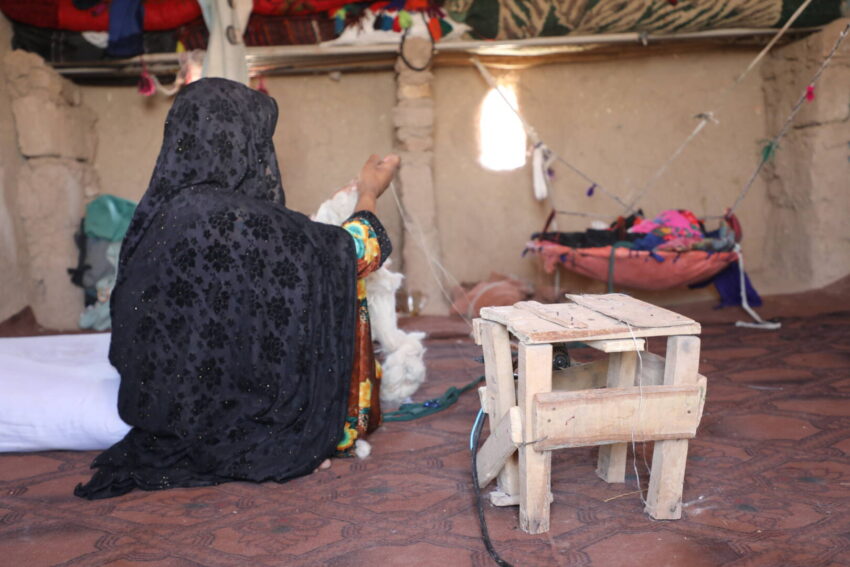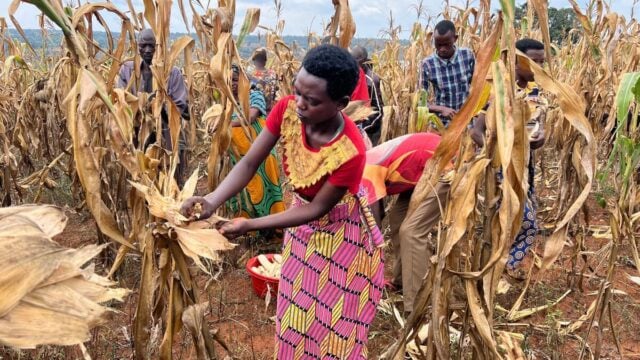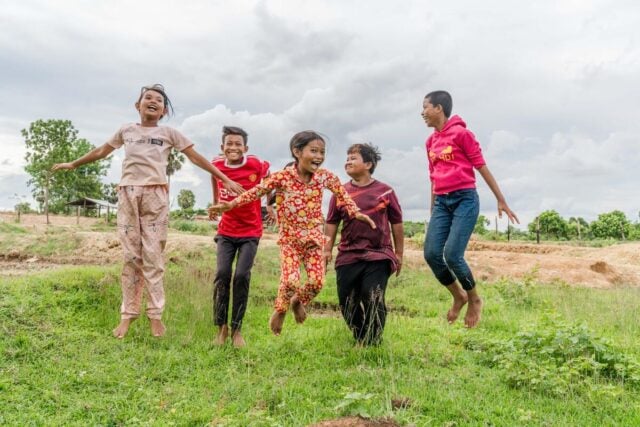We sit in a room made of mud with two-meter-high walls (about 6 ½ feet). The wall in front of us has two holes that allow a little sunlight into the room. A boy who looks about 7 years old peeks through the holes and then hides. There is no window or curtain or even plastic to prevent a strong wind from blowing dust into the room.
An old brown carpet spread on the floor doesn’t cover the length of the room. There is a purple bucket full of water. Near the middle of the room is a machine made from nailed-together pieces of wood, used to spin wool into yarn.
The last piece of furniture is a homemade cradle, composed of two ropes secured to the roof and fastened to a petal-shaped piece of rose-colored cloth that cradles a child below.
A mother, 30-year-old Zarghona*, pushes the cradle by hand so that her baby is lulled to sleep.
Zarghona, her face covered by a long black headscarf, shares the difficulties she has been experiencing.
“I could not bear watching my children crying for food anymore”
Her husband has mental health issues, she says, and it’s why she couldn’t rely on him to earn money for bread for her children.
“My brother-in-law, Almas, gave us food for two years. Then he forced me to sell my kidney so that he could look after us with that money,” Zarghona says.
Her children suffered from hunger. “I could not bear watching my children crying for food anymore, so I agreed to sell my kidney to save my children from dying of hunger,” Zarghona explains while crying.
Almas told her that he sold her kidney for 100,000 afghanis (about US$1,120), and he allowed Zarghona and her children to live in his house and eat food for one year. Soon after, her money was gone, he said. Almas’ attention turned to Zarghona’s 4-year-old daughter; he could sell the child for her dowry, meaning more money to support them for one more year. While illegal, child marriages are widespread in Afghanistan. As families struggle with increasing food insecurity and economic hardships, girls are increasingly at risk of child marriage to offset financial woes.
Zarghona refused and left everything behind, with one purpose — to save her five children from dying of starvation or having them sold off in marriage to feed the rest of the family. She fled Badghis Province to Herat, a distance of more than 100 miles, where her father lives in an informal camp for internally displaced people (IDP).
Spinning wool to stop hunger
Now she earns money by tailoring and making yarn from wool. She can rarely earn 100 afghanis (about US$1.10) per day. With this meager amount of money, she buys food for her children. Her father’s economic situation isn’t good, and he can’t provide much support.
Working all day without a break causes her pain, especially because of the wounds from her kidney surgery. “When I take medicine, my pain is relieved, but most of the time I cannot buy medicine. Instead of buying medicine for myself I prefer buying food for my children,” Zarghona continues after a pause, with trembling voice. “I can bear my pain, but cannot see my children crying for food.”
After a while Zarghona went back to Badghis to visit her husband. Her brother-in-law Almas asked her again if she would agree to give him another child, her 10-year-old daughter, to be married off for her dowry. When her daughter overheard, she cried and said to her mother, “I prefer dying from hunger rather than getting married. Let us die.”
Like Zarghona, millions of Afghans suffer as they hear their children crying for food but are unable to provide nourishment. An estimated 19.7 million Afghans — about 45% of the population — are facing high levels of acute food insecurity right now.
Dreams and hope for better days
When asked about her dreams, Zarghona answered, “My only dream is to be able to manage [and] fight the hunger and have enough food. I dream my children get some education and support me when they grow up enough.”
World Vision in Afghanistan provides health services through mobile health clinics for the families living in this IDP camp. Zarghona says when her children get sick, she takes them to this clinic because they cannot afford medication in the city.
In 2022, World Vision has been able to provide food, health services, or cash assistance to over 1 million vulnerable people. However, the needs are immense. World Vision has been working for more than 21 years in Afghanistan, and with support from generous donors, we remain committed and determined to stay and deliver in Afghanistan and make a difference for children, families, and communities.
*Name changed to protect identity




